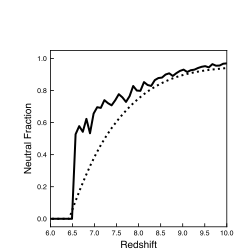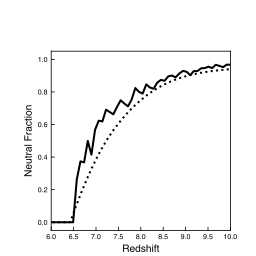Nicole Drakos
Research Blog
Welcome to my Research Blog.
This is mostly meant to document what I am working on for myself, and to communicate with my colleagues. It is likely filled with errors!
This project is maintained by ndrakos
Bubble Size Troubleshooting Part II
As discussed in my previous post, my reionization bubbles were growing too slowly. I suspect this is because I need to model the overlap of bubbles.
Add an ionized background
I attempted to approximate how much individual bubble sizes should increase by adding a background in the calculation; i.e. \(f_{ esc} \dot{N}_{ion}\) became \(f_{ esc} \dot{N}_{ ion} + \dot{N}_{background}\), where \(\dot{N}_{background} = \dot{n} Q V\), \(Q\) is the ionized fraction and \(V\) is the volume of the bubble.
In the previous post, I said this didn’t fix things, however, I made a mistake with my conversion to proper distances, and this actually mostly works!
Here is Case I (dotted line is the expected, solid line is the measured):

While this is much better than before, it still doesn’t match the expected curve very well.
Clumping
I also tried adding in a Clumping term (C=3, as used for the recombination term) to account for inhomogenities in the IGM:
\[\dot{N}_{background} = \dot{n} Q V C\]This worked even better:

Conclusions
I’m still not sure if this is the best way to model the bubbles, but I think it looks roughly right. I will proceed with this method, unless I come up with a better idea!
I will run this for Case II as well, and see how it compares. One thing to decide for Case II is whether I should just allow \(f_{\\rm esc}\) to vary with time. This would require modelling the evolution of the size/shape of the galaxy as well. Initially, I will just treat it as constant.
Then, the next steps will be calculating which galaxies are Lyman Alpha Emitters (I’ll start by following Yajima et al. 2018 for this part).